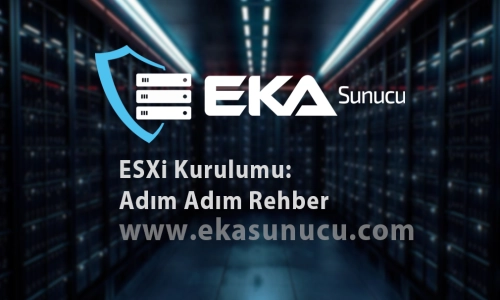
ESXi Installation: Step-by-Step Guide
Introduction: What is ESXi and Why Should We Use It?
VMware ESXi is one of the most commonly used virtualization platforms, allowing you to run physical servers as virtual machines (VMs). In this article, you will learn how to install VMware ESXi step by step.
Step 1: Check Hardware Requirements
Before starting the ESXi installation, review the hardware requirements. The basic requirements include:
- 64-bit x86 compatible processor
- Minimum 4 GB RAM (8 GB or more recommended)
- At least 1 Gigabit Ethernet connection
- Supported storage device (e.g., HDD, SSD, or SAN)
- Motherboard that supports VMware ESXi
Step 2: Download and Preparation of VMware ESXi
-
Go to VMware's official website and download the latest version of ESXi.
-
Use software like Rufus or Etcher to write the downloaded ISO file to a USB drive.
Step 3: ESXi Installation
-
Insert the ESXi installation media into your server's DVD drive or USB port.
-
Boot up your server and access the BIOS or UEFI settings. Change the boot settings and set the boot priority to DVD or USB.
-
Restart your server and boot from the installation media to start the ESXi installation.
-
When the installation wizard starts, select your language and keyboard settings.
Step 4: Enter License Key
- In the installation wizard, enter your license key or proceed with a trial license.
Step 5: Select Storage Devices
- Choose the option to select storage devices. ESXi will list all storage devices available for installation. Select your primary storage device.
Step 6: Configure Network Settings
- On the network settings screen, enter the IP address, subnet mask, gateway, and DNS information. It's recommended to use a static IP.
Step 7: Set Root Password
- Configure the root password and make sure it is strong and secure.
Step 8: Completion of Installation and Initial Startup
-
Once the installation is complete, your server will automatically restart and prepare ESXi for use.
-
Use your web browser to visit the IP address of your server, and start creating and managing virtual machines using vCenter or the vSphere Client.
Conclusion: You Have Successfully Completed the ESXi Installation
By following this step-by-step guide, you should have successfully installed VMware ESXi. You can now harness the power of virtualization to better manage your server resources and create a more efficient infrastructure.
 Turkey (Türkçe)
Turkey (Türkçe) Germany (German)
Germany (German) Worldwide (English)
Worldwide (English)




Yorumlar